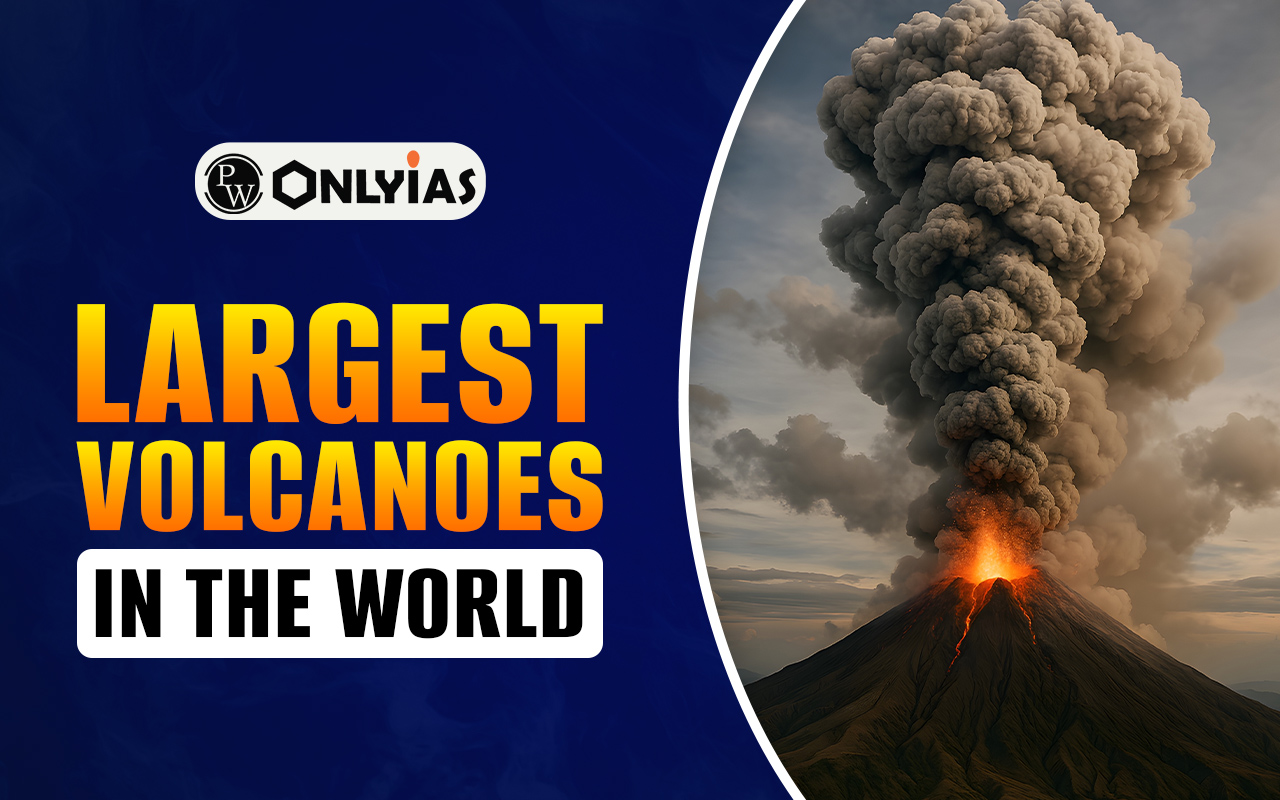Explore the Earth's largest volcanoes, including the shield volcano Mauna Loa. Discover the list of the largest volcanoes worldwide, their locations, and distribution—a valuable resource for competitive exam preparation.

Volcanoes are some of the largest and most powerful natural structures on Earth, shaping landscapes and influencing ecosystems. The biggest volcanoes, often found in areas with tectonic activity, vary widely in size, shape, and location. This article explores the largest volcanoes in the world, their global distribution, and where they are located.
Volcanoes are geological features formed by the eruption of molten rock, ash, and gases from beneath the Earth’s crust onto its surface. They are often located at the boundaries of tectonic plates, where the Earth’s lithospheric plates interact. Volcanic activity can take various forms, including explosive eruptions and gradual extrusions of lava.
Volcanoes vary in size, shape, and eruption style. Different types of volcanoes include:
Volcanic eruptions can vary in intensity and impact. They release gases such as water vapor, carbon dioxide, and sulfur dioxide into the atmosphere. While volcanic activity can be destructive, it also contributes to the creation of new land, mineral deposits, and the shaping of Earth’s surface over time.
India is home to several volcanoes, including active, dormant, and extinct types spread across different regions. The most notable are located in the Andaman and Nicobar Islands, known for volcanic activity, while other volcanoes in mainland India are mostly extinct and date back millions of years. The following table lists the key volcanoes in India along with their locations and activity status.
| List of Volcanoes in India | ||||
|---|---|---|---|---|
| Name | Elevation (meters) | Location | Last Eruption | Type |
| Barren Island | 354 | Andaman and Nicobar Islands | 2025 | Stratovolcano, Active |
| Narcondam Island | 710 | Andaman and Nicobar Islands | 1681 | Stratovolcano, Dormant |
| Deccan Plateau | 1500 | Andhra Pradesh, Karnataka, Maharashtra, Telangana | 25 million years ago | Caldera, Extinct |
| Baratang Island | 532 | Andaman and Nicobar Islands | Active since 2003 | Mud volcanoes, Active |
| Dhinodhar Hills | 386 | Gujarat | 500 million years ago | Extinct |
| Dhosi Hill | 740 | Haryana | 750 million years ago | Extinct |
| Tosham Hills | 207 | Haryana | 732 million years ago | Extinct |
| Loktak Lake | 768 | Manipur | 100 million years ago | Supervolcanic caldera, Status unknown |
Candidates can benefit from studying the list of the largest volcanoes in the world. This list provides insights into the geographical distribution, elevations, and distinctive characteristics of these remarkable natural formations. Exploring this information can enhance understanding of Earth’s geological processes and the impact of volcanoes on our planet’s diverse landscapes.
| Largest Volcanoes In the World | |||
|---|---|---|---|
| Feature & Location | Volcanoes in the World | Feet | Metres |
| Hawaii, U.S.A | Mauna Loa | 3085 | 9170 |
| Canary Islands, Spain | Teide | 24066 | 7500 |
| Hawaii, U.S.A | Haleakala | 30000 | 9144 |
| Reunion, France | Piton des Neiges | 23199 | 7071 |
| Argentina/Chile – Highest active volcano on Earth | Ojos del Salado | 22615 | 6893 |
| Argentina/Chile – Second highest active volcano on Earth | Llullaillaco | 22110 | 6739 |
| Ecuador – Second highest in Ecuador | Cotopaxi | 19347 | 5897 |
| Ecuador – Farthest point from Earth’s centre | Chimborazo | 20561 | 6267 |
| Bolivia – The highest peak of Bolivia | Nevado Sajama | 21463 | 6542 |
| Tanzania – Highest volcano outside South America; the highest peak in Africa | Kilimanjaro | 19341 | 5895 |
| Russia – Highest volcano in Eurasia; the highest peak in Russia | Mount Elbrus | 18510 | 5642 |
| Ecuador – Third highest in Ecuador | Cayambe | 18996 | 5790 |
| Mexico – Highest volcano in North America; the highest peak in Mexico | Pico de Orizaba | 18491 | 5636 |
| Iran – Highest volcano within Asia; the highest peak in Iran | Mount Damavand | 18406 | 5610 |
| Kenya – Second highest volcano in Africa; the highest mountain in Kenya | Mount Kenya | 17057 | 5199 |
| Mexico – Second highest volcano in North America | Popocatepetl | 17802 | 5426 |
| Mexico – Third highest volcano in North America | Iztaccihuatl | 17559 | 5230 |
| Turkey/Armenia – The highest mountain in Turkey | Mount Ararat | 16854 | 5137 |
| Georgia – Highest volcano in Georgia | Mount Kazbek | 16558 | 5047 |
| Alaska – highest volcano in the United States | Mount Bona | 16421 | 5047 |
| The Kamchatka Peninsula, Russia – highest active in Eurasia; the highest mountain in Siberia | Klyuchevskaya Sopka | 1584 | 4750 |
| Rwanda/Democratic Republic of Congo – highest mountain in Rwanda | Mount Karisimbi | 14787 | 4507 |
| Guatemala – highest mountain in Central America | Volcan Tajumulco | 13845 | 4220 |
| Papua New Guinea – highest volcano in Australasia and Pacific islands | Mount Giluwe | 14331 | 4368 |
| Washington – highest volcano in the contiguous United States | Mount Rainier | 14409 | 4392 |
| Hawaii, United States – World’s tallest mountain from base to summit | Mauna Kea | 13796 | 4205 |
| Antarctica – Highest volcano in Antarctica | Mount Sidley | 13717 | 4181 |
| Armenia – highest mountain in Armenia | Mount Aragats | 13435 | 4095 |
| Cameroon – highest mountain in Cameroon | Mount Cameroon | 13435 | 4095 |
| Sumatra, Indonesia – Highest volcano in Indonesia; the highest mountain in Sumatra | Mount Kerinci | 12484 | 3085 |
| Chubu Region, Honshu – highest mountain in Japan | Mount Fuji | 12388 | 3776 |
| Lombok, Indonesia – Second-highest volcano in Indonesia | Mount Rinjani | 1224 | 3726 |
| Tenerife, Canary Islands – the highest peak in the Atlantic Islands and Spain | Teide | 12198 | 3718 |
| Java, Indonesia – highest mountain in Java | Semeru | 12060 | 3676 |
| Chad – the highest mountain in Chad & the Sahara | Emi Koussi | 11204 | 3415 |
| Sicily – active; highest volcano in Western Europe; the highest peak in Italy south of the Alps | Mount Etna | 10922 | 3329 |
| Maui, Hawaii – the highest peak of Maui | Haleakala | 10023 | 3055 |
| Bali, Indonesia – highest mountain in Bali | Mount Agung | 9944 | 3031 |
| Bioko, Equatorial Guinea – the highest mountain in Equatorial Guinea | Pico Basile | 9879 | 3011 |
| Mindanao – highest mountain in the Philippines | Mount Apo | 9692 | 2954 |
| Oromia Region – highest volcano in Ethiopia | Mount Zuqualla | 9806 | 2989 |
| Unimak Island, Alaska – highest mountain in the Aleutian Islands | Mount Shishaldin (Sisquk) | 9373 | 2857 |
| Heard Island – the highest mountain in Australia | Mawson Peak | 9006 | 2745 |
| Azores – highest mountain in Portugal | Pico | 7713 | 2351 |
| Jan Mayen, Norway – highest volcano in Norway | Beerenberg | 7470 | 2277 |
| Argentina–Chile border region | Pali-Aike volcanic field | 591 | 180 |
| Batangas, Philippines – – Smallest volcano on earth | Taal Volcano | 1020 | 311 |
Volcanoes are not evenly distributed across the world; instead, they tend to cluster in certain regions due to tectonic plate boundaries and hotspot activity. Here’s a general overview of the distribution of volcanoes:
Determining the exact number of volcanoes on Earth proves challenging due to the continuous emergence of new ones and the transition of older ones into states of dormancy or extinction. Nevertheless, an estimated 1,500 volcanoes possess the potential for activity across the globe, and each year witnesses the eruption of roughly 50 to 70 of them. The preponderance of these volcanic formations encircles the Pacific Ocean, encompassing the well-known “Ring of Fire” region.
Check Out UPSC CSE Books
Visit PW Store
| Related Links | |
|---|---|
| Highest Mountain Peaks in India | List of Highest Waterfall in India |
| UPSC Geography Syllabus | UPSC Age Limit |
| ED Full Form | NDC Full Form |
| Must Read | |
| NCERT Notes For UPSC | UPSC Daily Current Affairs |
| UPSC Blogs | UPSC Daily Editorials |
| Daily Current Affairs Quiz | Daily Main Answer Writing |
| UPSC Mains Previous Year Papers | UPSC Test Series |
A volcano is a geological formation on Earth's surface that occurs when molten rock, ash, and gases escape from beneath the planet's crust through an opening known as a vent. This process is often accompanied by various volcanic activities, including eruptions, lava flows, and the release of gases.
Volcanoes are formed by the movement of tectonic plates in the Earth's crust. They can occur at convergent boundaries (where plates collide), divergent boundaries (where plates move apart), and hotspots (localized areas of intense heat beneath the crust).
The "Ring of Fire" is a horseshoe-shaped area around the Pacific Ocean characterized by high volcanic and seismic activity. It's home to a significant portion of the world's active volcanoes and is prone to frequent earthquakes due to the movement of tectonic plates.
The exact count of volcanoes worldwide is not fixed due to the dynamic nature of volcanic activity. Approximately 1,500 potentially active volcanoes are recognized globally, with the majority clustered around the Pacific Ocean in what's known as the "Ring of Fire."
There are several famous volcanoes around the world, including Mount Vesuvius in Italy, Mount Fuji in Japan, Mount St. Helens in the United States, and Mount Kilimanjaro in Tanzania. Hawaii's Mauna Loa and Kilauea are also well-known for their consistent activity.
<div class="new-fform">
</div>
